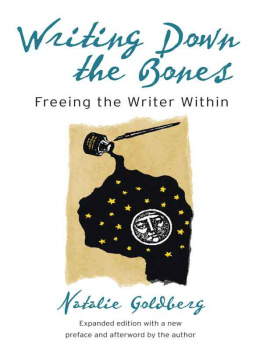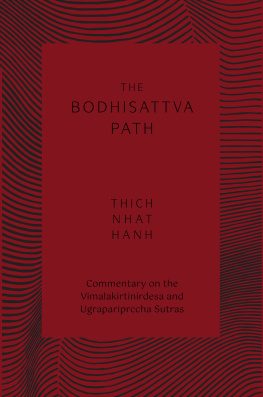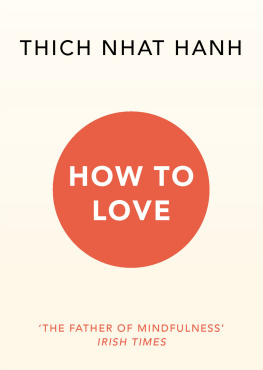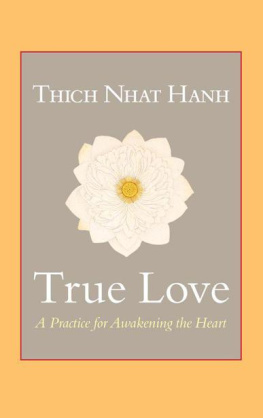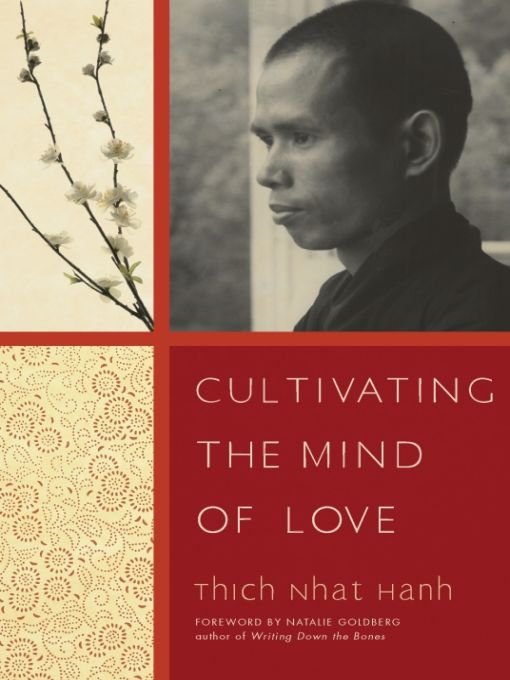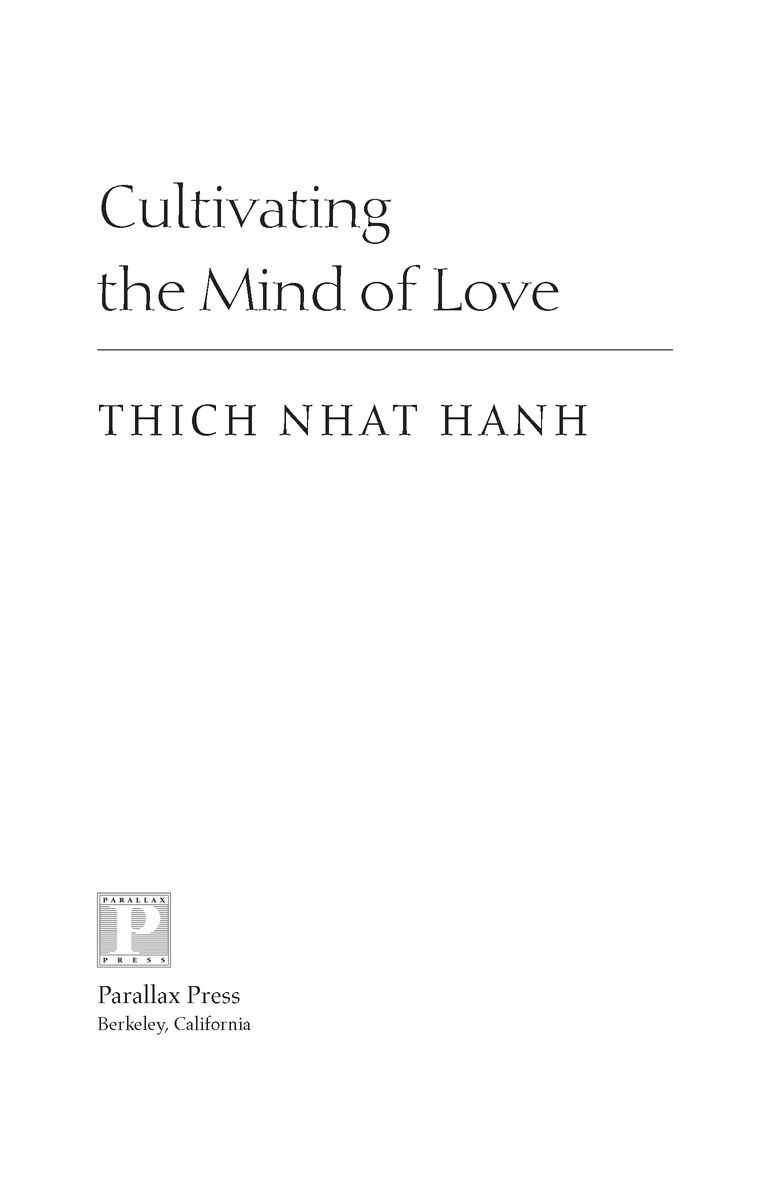Table of Contents
Foreword
I am continually amazed at how Thich Nhat Hanh is able to translate the Buddhist tradition into everyday life and make it relevant and helpful for so many people. Cultivating the Mind of Love just might be my favorite book of his, because its about one of our all-time favorite subjects and the one were all confused about: Love.
In June 1992, I was fortunate enough to attend the retreat in France where Thich Nhat Hanh gave the Dharma talks that became these pages. I will never forget how I felt listening to him. Here was a Zen master, committed to mindfulness, examining the nature of love. What is it? How do we handle it? Who are we in this state? What do we really want? Weve all been struck by love, but what do we do with it? Most of us tumble willy-nilly into it and lose clear perception, perspective, or common sense. Often what began with joy becomes a pitfall. But in the Dharma Nectar Hall in Plum Village, I listened to Thich Nhat Hanh, who stood steady in loves torrential waves, scrutinized it, and grounded it in deep practice.
Hearing Thay (Vietnamese for teacher), I felt for the first time that sanity had entered the realm of love. Each morning he lectured for two hours and I eagerly came early to the zendo and sat right in front of him. I was ready to have those teachings poured into me. It was a revelation to realize I did not necessarily have to be tossed about when Cupids arrow hit. I thought how compassionate he was to try to explain loves source to a Western world dazed and dazzled by the promise of romance and song lyrics full of yearning.
He talked about the Diamond, Avatamsaka, and Lotus Sutras. Then halfway into each morning, he switched the subject and told us another episode of his falling in love as a young monk with a nun. Falling in love is an accident, he said. Think about it: the expression falling; you trip into it. It was not supposed to happen. After all, I was a monk; she was a nun. He did not act upon it in a capricious way, as we normally do. He examined these strong feelings with awareness and then, more than forty years later, he shared the benefit of that with us. I realized he was teaching us how to love well.
I flip through my notebook now and see the notes I took then. They seem to glimmer off the page:
Your first love has no beginning or end. Your first love is not your first love, and it is not your last. It is just love. It is one with everything.
The present moment is the only moment available to us, and it is the door to all moments.
No coming. No going. Everything is pretending to be born and to die.
This self has no self.
It is okay to suffer in the process of love.
Everyone in the hall felt the instant recognition of what he said, though it often bypassed our logical brain and went directly into our hearts. Yes, we thought, love is much more than chocolate bonbons on Valentines Day.
One morning I had an idea and wrote a note to Thay: Why dont all of us write for half an hour about our first love, examining those feelingsthe texture, the light and dark we felt. I thought it was a great opportunity to investigate our experience. I realized then that the work of a Zen master is also the work of a writerto take nothing for granted but to live deeply and feel the life we have been given. It is also the work of everyone if we are to bring peace to this world. It is our chance to glimpse the interconnected nature of all things and how our first love has no beginning or end. The next day Thay read my note aloud to the Sangha and encouraged them all to write. I encourage the readers of this book to do the same.
In Taos, New Mexico, where I live and where a small Sangha gathers every Wednesday night to meditate, walk, recite the precepts, and share tea, we now also read aloud two pages from this book at each meeting. It is our hope to digest it gradually, so what we learn becomes rooted. We know this simple book can change the face of our interactions, our motives, our minds.
I urge you to take in Thich Nhat Hanhs words slowly, the way molasses pours in winter, so you will nourish your whole being and so we may walk more kindly on this Earth.
Natalie Goldberg
Taos, New Mexico
June 1995
INTRODUCTION
Dharma Rain
This book comes from a series of talks I gave about my first love. Everyone at Plum Village, the community where I live and practice in France, was very concentrated. They were listening with the whole of their being, not just with their intellect. When a subject is interesting, you dont need to work hard to read or listen. Concentration is there without effort, and understanding is born from concentration.
My hope is that when you read this book, you will allow the rain of the Dharma to penetrate the soil of your consciousness. Dont think too much; dont argue or compare. Playing with words and ideas is like trying to catch rain in buckets. Just allow your consciousness to receive the rain, and the seeds buried deep within will have a chance to be watered.
Consciousness in Buddhism is said to be composed of two partsstore consciousness (alayavijana) and mind consciousness (manovijana). In our store consciousness are buried all the seeds, representing everything we have ever done, experienced, or perceived. When a seed is watered, it manifests in our mind consciousness.
The work of meditation is to cultivate the garden of our store consciousness. As gardeners, we have to trust the land, knowing that all the seeds of love and understanding, of enlightenment and happiness, are already there. Thats why we dont have to think too hard or take notes during a Dharma talk. We only need to be there, to allow the seeds of love and understanding that are buried deep within us to be watered. Its not just the teacher whos giving the Dharma talk. The violet bamboo, the yellow chrysanthemum, and the golden sunset are all speaking at the same time. Anything that waters these deepest seeds in our store consciousness is the true Dharma.
When a woman becomes pregnant, her body and her spirit transform. A new energy may arise within her that allows her to do things she previously could not. If all is well in her life, this may be a time of great joy. Even when they feel unwell, during this time some women feel a great peace that radiates outward.
We who practice meditation can learn from this. There is a baby Buddha in our store consciousness, and we have to give him or her a chance to be born. When we touch our baby Buddhathe seeds of understanding and love that are buried within uswe become filled with bodhicitta, the mind of enlightenment, the mind of love. From that moment on, everything we do or say nourishes the baby Buddha within us, and we are filled with joy, confidence, and energy. According to Mahayana Buddhism, awakening to our mind of love is the moment the practice begins.
Our mind of love may be buried deep in our store consciousness, under many layers of forgetfulness and suffering. The teachers role is to help us water it, to help it manifest. In Zen Buddhism, the teacher may propose a koan, and if teacher and student are lucky and skillful enough, the students mind of enlightenment will be touched. The student buries the koan deep in her store consciousness, and her practice is to nourish the koan with her mindfulness, being aware of whatever she is doing, whether it is sweeping the floor, washing the dishes, or listening to the bell. She entrusts the koan to her store consciousness, just as a woman who is pregnant trusts her body to nourish her baby.


